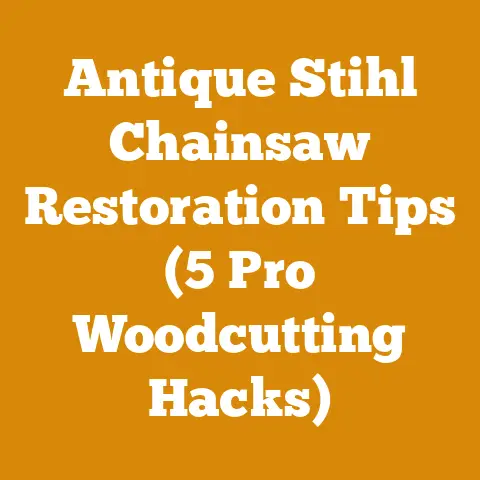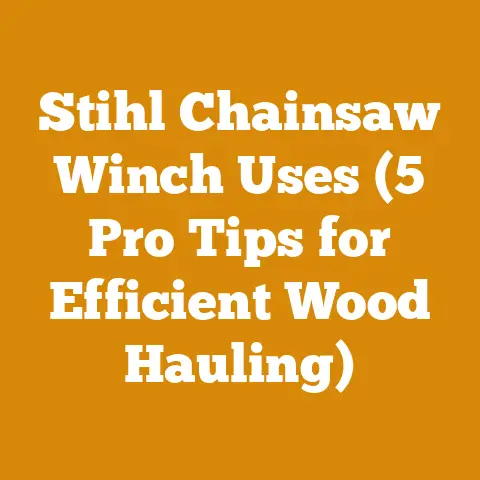Mulcher for Sub Compact Tractor (5 Pro Tips for Buckthorn Cleanup)
Investing in a mulcher for your sub-compact tractor is a significant decision, one that requires careful consideration. It’s not just about the initial cost; it’s about the long-term value, the time you’ll save, and the effectiveness with which you can tackle challenging tasks like buckthorn cleanup. I’ve spent years wrestling with invasive species on my own property, and I’ve learned firsthand that having the right tools can make all the difference. In this article, I’ll share my experiences and insights, focusing on how to choose and use a mulcher for your sub-compact tractor to reclaim your land from the relentless advance of buckthorn.
Key Takeaways:
- Proper Mulcher Selection: Matching the right mulcher to your tractor’s capabilities and the specific challenges of buckthorn cleanup is crucial.
- Optimized Technique: Mastering the right mulching techniques maximizes efficiency and minimizes strain on both you and your equipment.
- Preventative Maintenance: Regular maintenance extends the life of your mulcher and ensures consistent performance.
- Safety First: Prioritizing safety with proper gear and awareness of your surroundings is non-negotiable.
- Strategic Approach: A well-planned approach to buckthorn removal ensures long-term success and prevents re-infestation.
Mulcher for Sub Compact Tractor: 5 Pro Tips for Buckthorn Cleanup
The Investment: More Than Just a Purchase
When I first considered buying a mulcher, I was hesitant. The price tag seemed steep, especially for a sub-compact tractor owner like myself. I’d been using chainsaws, brush cutters, and even manual labor to keep the buckthorn at bay, but it felt like I was constantly losing ground. The turning point came when I realized the true cost of my “cheaper” methods: the hours of back-breaking work, the wear and tear on my body, and the slow but steady encroachment of buckthorn that threatened to take over my property.
Think of it this way: a mulcher is an investment in your time, your health, and the long-term value of your land. According to a study by the University of Minnesota Extension, buckthorn infestations can reduce property values by up to 20% in severely affected areas. That’s a significant financial hit.
The initial investment in a mulcher can range from \$3,000 to \$10,000 or more, depending on the size, type, and features. However, consider the potential return on investment:
- Reduced Labor Costs: No more hiring crews to manually cut and remove buckthorn.
- Increased Efficiency: Mulchers can clear acres of land in a fraction of the time it would take with manual methods.
- Improved Land Value: By controlling buckthorn, you protect and enhance the value of your property.
- Health Benefits: Less physical strain means fewer aches, pains, and potential injuries.
Tip #1: Matching the Mulcher to Your Tractor and the Task
The first and most crucial step is selecting the right mulcher for your sub-compact tractor. Not all mulchers are created equal, and pairing the wrong one with your machine can lead to frustration, damage, or even dangerous situations.
Understanding Your Tractor’s Capabilities:
Sub-compact tractors typically range from 15 to 30 horsepower. It’s vital to know your tractor’s horsepower rating, PTO horsepower, and hydraulic flow rate. This information is usually found in your tractor’s owner’s manual or on a sticker located on the machine.
- Horsepower: Determines the size and type of mulcher your tractor can handle. Generally, you’ll want a mulcher that requires less horsepower than your tractor’s PTO output to avoid overloading the engine.
- PTO Horsepower: This is the power available to run implements like mulchers.
- Hydraulic Flow Rate: If you’re considering a hydraulic mulcher, your tractor’s hydraulic flow rate must be sufficient to power the mulcher’s motor.
Types of Mulchers for Sub-Compact Tractors:
- Rotary Mowers/Brush Hogs: These are the most common and affordable option. They use rotating blades to chop vegetation. While they can handle smaller buckthorn saplings, they may struggle with larger stems and dense growth. They are best for maintaining already cleared areas and managing light infestations.
- Flail Mowers/Mulchers: These use a series of small, hinged flails to shred vegetation. They are more effective than rotary mowers at handling thicker brush and can produce a finer mulch. They are a good middle-ground option for sub-compact tractors.
- Disc Mulchers: These feature a rotating disc with teeth or knives that grind vegetation into mulch. They are more aggressive than flail mowers and can handle larger buckthorn stems. However, they typically require more horsepower and may be too much for some sub-compact tractors.
- Hydraulic Mulchers: These are powered by the tractor’s hydraulic system and are often the most powerful and versatile option. They can handle thick brush, large trees, and even grind stumps. However, they are also the most expensive and require a tractor with sufficient hydraulic flow.
Matching the Mulcher to the Buckthorn Challenge:
Buckthorn infestations vary in density and stem size. Consider the following:
- Light Infestation: Scattered saplings and small stems (under 2 inches in diameter). A rotary mower or flail mower may be sufficient.
- Moderate Infestation: Dense growth with stems up to 4 inches in diameter. A flail mower or disc mulcher would be a better choice.
- Heavy Infestation: Thick stands of buckthorn with stems larger than 4 inches in diameter. A hydraulic mulcher is likely necessary.
Example:
I have a 25-horsepower sub-compact tractor with a PTO horsepower of around 20. I initially tried using a heavy-duty rotary mower, but it struggled with buckthorn stems larger than 1.5 inches. I eventually upgraded to a flail mower specifically designed for sub-compact tractors, and it made a world of difference. It could handle stems up to 3 inches in diameter and produced a much finer mulch, which helped suppress regrowth.
Expert Insight:
“Don’t underestimate the importance of matching the mulcher to the task,” says John Davis, a land management consultant with over 20 years of experience. “Using too small of a mulcher will lead to frustration and inefficient work, while using too large of a mulcher can damage your tractor or create a safety hazard.”
Actionable Step:
Before you buy a mulcher, research your tractor’s specifications and assess the density and stem size of the buckthorn on your property. Consult with a dealer or experienced user to determine the best mulcher for your needs.
Tip #2: Mastering the Mulching Technique
Having the right mulcher is only half the battle. Mastering the proper mulching technique is essential for maximizing efficiency, minimizing strain on your equipment, and achieving the best results.
Understanding the Basics:
- Forward Speed: Adjust your tractor’s forward speed to match the density of the buckthorn. Slower speeds are necessary for thick growth, while faster speeds can be used in lighter infestations.
- Cutting Height: Set the cutting height of your mulcher to achieve the desired mulch size. Lower cutting heights will produce finer mulch, while higher cutting heights will leave larger pieces.
- Overlap: Overlap each pass by at least 25% to ensure complete coverage and prevent missed areas.
- Direction: Mulch in the direction of the buckthorn stems to prevent them from being pushed over without being cut.
Specific Techniques for Buckthorn Removal:
- Top-Down Approach: For larger buckthorn stems, start by mulching the top of the plant and then gradually work your way down to the base. This prevents the entire plant from falling over at once and potentially damaging the mulcher.
- Angle of Attack: Approach buckthorn stems at a slight angle to allow the mulcher to bite into the wood more effectively.
- Multiple Passes: In heavily infested areas, make multiple passes to ensure that all buckthorn stems are thoroughly mulched.
- Stump Grinding (with appropriate mulcher): Some hydraulic mulchers can be used to grind stumps below ground level, preventing regrowth. If your mulcher is capable, this is a highly effective method for long-term buckthorn control.
Personal Experience:
When I first started using my flail mower, I tried to go too fast. I ended up leaving behind a lot of half-mulched stems and putting unnecessary strain on my tractor. I quickly learned that slowing down and taking my time was the key to success. I also discovered that approaching the buckthorn at a slight angle allowed the flails to grab onto the stems more effectively.
Case Study:
A study conducted by the Wisconsin Department of Natural Resources found that using a mulcher in combination with herbicide application was the most effective method for controlling buckthorn in a forested area. The mulcher removed the bulk of the vegetation, while the herbicide prevented regrowth from the roots.
Expert Insight:
“Patience is key when mulching buckthorn,” says Sarah Johnson, a certified arborist specializing in invasive species management. “Don’t rush the process. Take your time and make sure you’re thoroughly mulching each stem.”
Actionable Step:
Practice your mulching technique in a less sensitive area before tackling your main buckthorn infestation. Experiment with different forward speeds, cutting heights, and angles of attack to find what works best for your equipment and the specific challenges on your property.
Tip #3: Preventative Maintenance: Keeping Your Mulcher Running Smoothly
A mulcher is a complex piece of machinery that requires regular maintenance to ensure optimal performance and longevity. Neglecting maintenance can lead to breakdowns, costly repairs, and even safety hazards.
Essential Maintenance Tasks:
- Daily Inspection: Before each use, inspect the mulcher for any signs of damage, such as loose bolts, cracked welds, or worn blades/flails.
- Greasing: Grease all moving parts regularly, following the manufacturer’s recommendations. This will reduce friction and prevent wear.
- Blade/Flail Replacement: Replace worn or damaged blades/flails as needed. Dull blades/flails will reduce mulching efficiency and put extra strain on the equipment.
- Belt Tension: Check and adjust belt tension regularly. Loose belts can slip and cause the mulcher to lose power.
- Oil Changes (for hydraulic mulchers): Change the hydraulic oil and filter according to the manufacturer’s recommendations. Contaminated oil can damage the hydraulic motor.
- Cleaning: Clean the mulcher after each use to remove debris and prevent rust.
- Storage: Store the mulcher in a dry, sheltered location when not in use.
Data Point:
A study by the Equipment Dealers Association found that regular maintenance can extend the life of a mulcher by up to 50%. This translates to significant cost savings over the long term.
Personal Story:
I learned the importance of regular maintenance the hard way. I neglected to grease the bearings on my flail mower, and they eventually seized up, causing the mower to overheat and shut down. The repair cost me several hundred dollars and a lot of downtime. Now, I make it a point to grease all moving parts before each use.
Expert Insight:
“Preventative maintenance is the key to keeping your mulcher running smoothly and avoiding costly repairs,” says Tom Miller, a small engine mechanic with over 30 years of experience. “A little bit of maintenance goes a long way.”
Actionable Step:
Create a maintenance schedule for your mulcher and stick to it. Consult your owner’s manual for specific maintenance recommendations. Keep a log of all maintenance tasks performed.
Tip #4: Safety First: Protecting Yourself and Others
Operating a mulcher can be dangerous if proper safety precautions are not followed. Flying debris, sharp blades/flails, and heavy machinery can all pose a risk of injury.
Essential Safety Measures:
- Personal Protective Equipment (PPE): Always wear appropriate PPE, including:
- Safety Glasses or Goggles: To protect your eyes from flying debris.
- Hearing Protection: To protect your ears from the loud noise of the mulcher.
- Gloves: To protect your hands from cuts and abrasions.
- Long Pants and Sleeves: To protect your skin from flying debris.
- Steel-Toed Boots: To protect your feet from injury.
- Hard Hat: Especially when working in wooded areas.
- Clear the Area: Before starting the mulcher, clear the area of any obstacles, such as rocks, branches, or debris.
- Keep Bystanders Away: Keep bystanders at least 100 feet away from the mulcher while it is in operation.
- Never Work Alone: Always have someone nearby in case of an emergency.
- Know Your Equipment: Familiarize yourself with the mulcher’s operating instructions and safety features.
- Stay Alert: Pay attention to your surroundings and avoid distractions.
- Take Breaks: Avoid fatigue by taking frequent breaks.
- Never Operate Under the Influence: Never operate a mulcher while under the influence of alcohol or drugs.
Statistics:
According to the Centers for Disease Control and Prevention (CDC), approximately 17,000 people are treated in emergency rooms each year for injuries related to lawn and garden equipment. Many of these injuries could be prevented by following proper safety precautions.
Real-Life Example:
I once witnessed a neighbor operating a brush hog without wearing safety glasses. A rock flew out from under the mower and struck him in the face, causing a serious eye injury. This incident reinforced the importance of always wearing appropriate PPE.
Expert Insight:
“Safety should always be your top priority when operating a mulcher,” says Mark Thompson, a safety consultant specializing in agricultural equipment. “Never take shortcuts or compromise on safety.”
Actionable Step:
Review the safety instructions for your mulcher and make sure you understand them thoroughly. Create a safety checklist and follow it every time you operate the mulcher.
Tip #5: Strategic Approach: Long-Term Buckthorn Control
Mulching buckthorn is an effective way to remove existing vegetation, but it’s not a permanent solution. Buckthorn is a persistent plant that can resprout from its roots and seeds. To achieve long-term control, you need a strategic approach that combines mulching with other methods.
Integrated Pest Management (IPM) Approach:
- Prevention: Prevent buckthorn from becoming established in the first place by maintaining healthy vegetation and controlling soil disturbance.
- Monitoring: Regularly monitor your property for signs of buckthorn infestation.
- Identification: Accurately identify buckthorn and differentiate it from other similar plants.
- Thresholds: Determine the level of buckthorn infestation that you can tolerate.
- Control Methods: Choose the most effective and environmentally sound control methods for your situation.
- Evaluation: Evaluate the effectiveness of your control methods and adjust your strategy as needed.
Specific Strategies for Long-Term Buckthorn Control:
- Mulching: Remove existing buckthorn vegetation.
- Herbicide Application: Apply herbicides to prevent regrowth from roots and seeds. Glyphosate and triclopyr are two common herbicides used to control buckthorn.
- Prescribed Burning: Use prescribed burning to kill buckthorn seedlings and saplings.
- Hand Pulling: Hand pull small buckthorn seedlings and saplings, especially in sensitive areas where herbicides cannot be used.
- Planting Native Vegetation: Plant native trees, shrubs, and grasses to compete with buckthorn and prevent it from re-establishing.
- Regular Monitoring: Regularly monitor your property for signs of buckthorn regrowth and take action as needed.
Data Point:
A study by the University of Minnesota Extension found that a combination of mulching, herbicide application, and planting native vegetation was the most effective method for long-term buckthorn control.
Personal Experience:
I initially thought that mulching alone would be enough to control the buckthorn on my property. However, I quickly learned that it would resprout from the roots within a few weeks. I started applying herbicide to the cut stumps, and it made a huge difference. I also planted native trees and shrubs to help shade out the buckthorn seedlings.
Expert Insight:
“Long-term buckthorn control requires a multi-faceted approach,” says Lisa Peterson, a restoration ecologist specializing in invasive species management. “Don’t rely on a single method. Combine mulching with other techniques to achieve the best results.”
Actionable Step:
Develop a long-term buckthorn control plan for your property. Incorporate a combination of mulching, herbicide application, planting native vegetation, and regular monitoring.
Conclusion: Reclaiming Your Land, One Mulch at a Time
Investing in a mulcher for your sub-compact tractor is a significant step towards reclaiming your land from the relentless advance of buckthorn. By carefully selecting the right mulcher, mastering the proper technique, maintaining your equipment, prioritizing safety, and implementing a strategic approach, you can effectively control buckthorn and restore the health and beauty of your property.
Remember, it’s not just about removing the buckthorn; it’s about creating a sustainable ecosystem that is resistant to future invasions. By planting native vegetation and regularly monitoring your property, you can ensure that your efforts are long-lasting.
So, take the plunge, invest in a mulcher, and start reclaiming your land. It’s an investment you won’t regret. And remember, I am here to help you along the way. Share your stories, ask your questions, and let’s work together to combat the spread of buckthorn and protect our precious natural resources.






